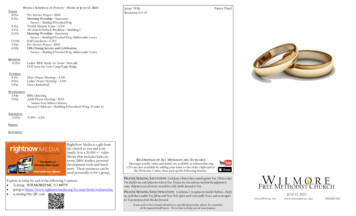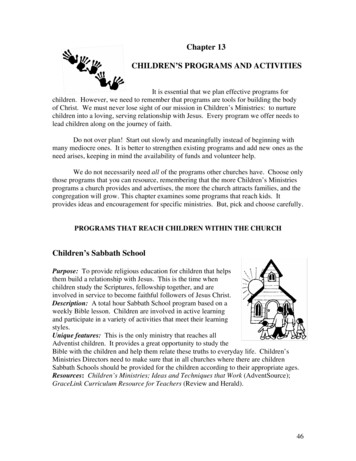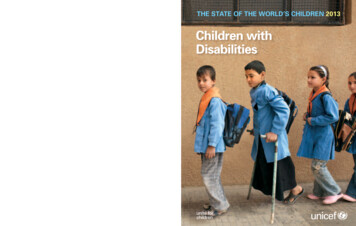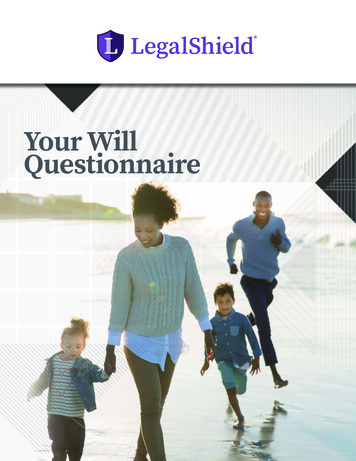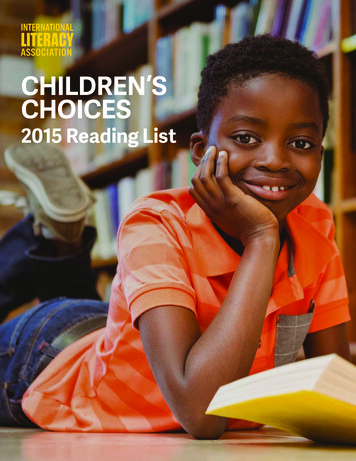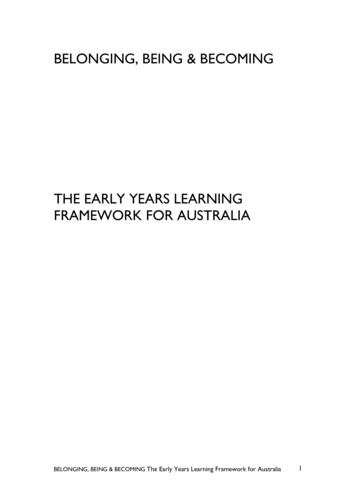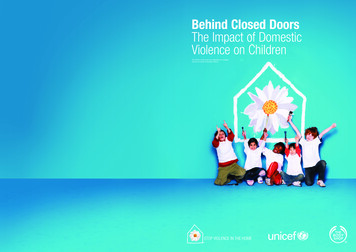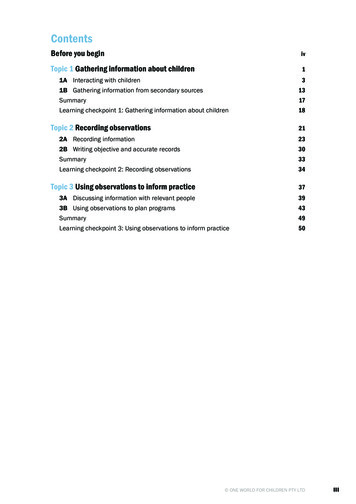
Transcription
ContentsBefore you begin ivTopic 1 Gathering information about children 11A Interacting with children 31B Gathering information from secondary sources 13Summary 17Learning checkpoint 1: Gathering information about children 18Topic 2 Recording observations 212A Recording information 232B Writing objective and accurate records 30Summary 33Learning checkpoint 2: Recording observations 34Topic 3 Using observations to inform practice 373A Discussing information with relevant people 393B Using observations to plan programs 43Summary 49Learning checkpoint 3: Using observations to inform practice 50iii
Topic 1In this topic you will learnabout:1A Interacting withchildren1B Gathering informationfrom secondarysourcesGathering informationabout childrenIn your daily work as an educator, you will makeobservations about the strengths, interests anddevelopment of children. Observing children in theirusual play patterns and daily interactions can helpyou to understand their individual strengths, interestsand needs as they develop.Collecting information from secondary sources,including families, colleagues and specialists, isanother way to find out vital information aboutchildren.1
CHCECE013 USE INFORMATION ABOUT CHILDREN TO INFORM PRACTICEThe following table maps this topic to the National Quality Standard and Belonging,being and becoming: The early years learning framework for Australia.National Quality StandardQuality Area 1: Educational program and practiceQuality Area 2: Children’s health and safetyQuality Area 3: Physical environmentQuality Area 4: Staffing arrangements Quality Area 5: Relationships with children Quality Area 6: Collaborative partnerships with families and communitiesQuality Area 7: Governance and leadershipEarly Years Learning FrameworkPrinciples Secure, respectful and reciprocal relationships PartnershipsHigh expectations and equityRespect for diversityOngoing learning and reflective practicePractice Holistic approaches Responsiveness to childrenLearning through playIntentional teachingLearning environmentsCultural competenceContinuity of learning and transitions Assessment for learningOutcomesChildren have a strong sense of identityChildren are connected to and contribute to their world Children have a strong sense of wellbeing Children are confident and involved learnersChildren are effective communicators2 ONE WORLD FOR CHILDREN PTY LTD
Topic 1 Gathering information about childrenThe following examples illustrate how an educator may learn aboutindividual children by observing them:XXLisa demonstrates she doesn’t understand the rules of the game when she runs awaywith the ball and starts her own game.XXJo demonstrates an understanding of friendship when she tells others that Kiera is herfriend and they like each other because they both play with dolls.XXVera demonstrates that she understands the rules of indoor time when she explains toSally that they need to use a quiet voice and walk inside.XXFrederick demonstrates his ability to communicate socially when he discusses his newlittle sister at group time.XXReece demonstrates an interest in bugs and spiders during playtime.Developmental aspectsYou can learn about children by observing their behaviour.Whatever the age of a child, you should notice:XX aspects of their development, including physical, social, emotional, cognitive andcommunication developmentXX the child’s interests, ideas and abilitiesXX the child’s knowledge, skills and understandingXX how they react in the play environment.It is recommended that skills, abilities and knowledge are a focus of your program. Inthis way, you are providing children with a positive environment that they feel capableof participating in.The following tables provide an overview of developmental aspects, and the skillsand abilities you may expect to observe in children of different ages and stages ofdevelopment.AgePhysical aspects0–3 monthsXXBrings hand to mouthTakes swipes at dangling objectsXX Opens and shuts handsXX Raises head momentarily while lying on stomachXX Reflexively grasps finger or object placed in their handXX3–6 monthsCan reach for things voluntarilyXX Holds head upright in a sitting positionXX Holds head upright for longer periods while lying on stomachXX5
CHCECE013 USE INFORMATION ABOUT CHILDREN TO INFORM PRACTICEAgeCommunication aspects0–6 monthsXXCoos back and forth with caregiverCapable of responding to their own name (4–5 months)XX Pays attention to human voices more than any other noiseXX Gives and receives communicationXX Imitates and responds to someone speakingXX6–12 monthsXX12–24 monthsXX2–3 yearsXXUntil 8–12 months, communicates by crying, cooing, babbling,imitating, making facial expressions, using body language andgesturesXX Can respond to simple verbal requestsXX Begins to imitate spoken wordsXX First words may be spokenHas a vocabulary of approximately 5–20 wordsXX Vocabulary is made up chiefly of nounsXX May repeat a word or phrase over and overXX Is able to follow simple commandsCan name a number of objects common to their surroundingsIs able to use at least two prepositions, usually ‘in’, ‘on’ or ‘under’XX Approximately two-thirds of what the child says is intelligibleXX Has a vocabulary of approximately 150–300 wordsXX Can use two pronouns correctly; for example, ‘I’, ‘me’ or ‘you’,although ‘me’ and ‘I’ are often confusedXX The words ‘my’ and ‘mine’ are beginning to emergeXX Can respond to commands such as ‘show me your nose’XX3–5 yearsXXAgeCognitive aspects0–12 monthsXX12–24 monthsXXUses clear speech with only a few grammatical errorsXX More complex speech patterns and vocabulary emergeXX Asks questionsXX Tells stories and recalls past eventsXX Understands advanced concepts such as ‘same’ and ‘different’XX May be capable of reciting their name and addressGains information through all senses: sight, hearing, smell, tasteand touchXX Explores objects in a variety of ways; for example, by shaking,banging or dropping themRecognises own facial featuresAcquires the notion of object permanenceXX Begins to sort shapes and coloursXX2–3 yearsProblem-solving skills increaseCan complete a four-piece puzzleXX Participates in make-believe playXX Can sort by shape and colourXXXX8 ONE WORLD FOR CHILDREN PTY LTD
Topic 1 Gathering information about childrenf.What did the child tell you?g. What did you ask the child?h. What did you find out from interacting with the child?2. Read the case study, and then answer the question that follows.Case studyPeter, an educator, is observing four-year-old Lisa, who is playing in the sandpit.Karen, another educator, is helping a different child build a sandcastle as Lisa watches.Karen asks Lisa if she would like to build a sandcastle. Lisa smiles, so Karen hands hera bucket and shovel. Lisa turns away from Karen and sits with Charles, a boy she ofteninteracts with. She uses both hands to grasp the shovel to fill her bucket with sand. Oncethe bucket is full, she turns it upside down.Peter has never observed Lisa building a castle before, so he is quite interested.The sand pours from the bucket as Lisa turns the bucket over; at least half of the sand poursfrom the bucket before Lisa can fully turn it upside down. Lisa begins to scowl and Charlesstarts to laugh. Lisa screws up her face and lets out a sob. She then throws her shovel,which hits Charles on his leg. Charles continues to laugh as Lisa stands up and kicks thebucket out of her way.As she leaves the sandpit, Lisa picks up her doll.Write down what you notice about Lisa’s behaviour with regard to the followingareas:Aspects of her developmentXX Her interests and skillsXX Her needsXX Social interactionsXX Her knowledge, skills and understandingXX11
CHCECE013 USE INFORMATION ABOUT CHILDREN TO INFORM PRACTICETo communicate effectively with families you may:XXask parents and family members to fill in forms, such as enrolment formsXXprovide opportunities for parents and family members to participate in feedbackmethods, such as suggestion boxes or surveysXXinvolve parents and family members in discussions at drop-off or pick-up timesXXdevelop methods where parents and family members can write or recordinformation, when necessaryXXask specific questions about their childXXshare the information you have gathered about the child and ask them to addany further details or clarify the information.Watch this video about interacting with children’s families.When families provide information, ensure that you show interestand encourage them to continue. To facilitate the effectiveexchange of information with parents, you must make yourselfavailable to speak with them at appropriate times. This availabilitymay vary according to the structure of your service, and your roleand responsibilities.You can make yourself available to communicate and shareinformation with parents and family members when:children and parents arrive at the service at the start of the dayXX parents arrive to collect their childrenXX talking on the phoneXX having organised care review meetingsXX parents participate in activitiesXX chatting informally in a tea and coffee areaXX parents and/or family members drop in during the day.XXBy planning to share information at these times, you show that your service valuescommunication. Parents appreciate this knowledge transfer as it demonstrates thatyou are willing to meet the individual needs of their child.14 ONE WORLD FOR CHILDREN PTY LTDv 0007Sharing information with families
CHCECE013 USE INFORMATION ABOUT CHILDREN TO INFORM PRACTICELearning checkpoint 1Gathering information about childrenObserve, listen to and interact with three different children during their normal patternof play and daily interactions.1. Interact with each child to identify a point of interest. The point of interest might:identify a key topic of interest they haveXX be an idea they express about an item, issue or situationXX demonstrate their knowledge about an item or issueXX show a skill that the child demonstrates.XXDescribe the interactions you had with the children, including:a. What you saidb. What the children said2. Gather information from a secondary source, such as co-workers or a child’sparents. Focus on one child and include details about all of the child’sdevelopmental aspects, including their:interestsXX likesXX dislikesXX routinesXX languageXX reactions to the play environmentXX18 ONE WORLD FOR CHILDREN PTY LTDfamilyXX religionXX cultureXX cultural practicesXX social interactions.XX
CHCECE013 USE INFORMATION ABOUT CHILDREN TO INFORM PRACTICEEnsuring confidentialityAll documentation about children is confidential. It is for the purpose of supportingcurriculum planning. Ensure parents give permission to use these records within theservice for programming purposes.Parental permission must be obtained prior to the records being shown to any personoutside the service or being used for any purpose other than for program planning.You must also store your records in a place where unauthorised people can’t read oraccess them; for example, in a lockable filing cabinet.Methods of recording observationsThere are various ways you can gather and record your observations of children. Somecommon methods are outlined in the following information.Discussion with familiesOrientation is a time to collect documentation about children and their families, andto develop open verbal communication. Most services update their documentedinformation regularly, but the daily discussions you have with parents are where mostof your important information should come from as you ask questions and listen to thedetails parents share with you.QuestioningQuestioning is useful, particularly when workingwith older children. You can question childrendirectly, or you can develop a questioning methodthat allows children to consider and reply in theirown time.Daily evaluation sheets, surveys, questionnairesand forms are some examples of questioningmethods. A daily evaluation sheet asks others toevaluate how the day went by providing specificquestions, such as what activities were enjoyedmost, what could be extended or what ways thecurriculum can be improved.‘Graffiti sheets’ can also be used to brainstorm: ask a question and have various peopleadd their ideas to it.Not all questioning is useful; sometimes children respond inappropriately or provide aresponse that they think you or their peers would like to hear rather than respondinghonestly.Verbal questioning may be recorded in a variety of ways; for example, you may use ajotting or anecdotal record, tick off a checklist, or make notes against an anticipated setof responses.24 ONE WORLD FOR CHILDREN PTY LTD
Topic 2 Recording observationsIdentifying objectivesLearning stories lead you to identify objectives. The things you notice about childrenwhen creating learning stories help you plan objectives for them. Objectives areessential as they help you to plan programs for children that are realistic and withintheir abilities.As you become more skilled at writing learning stories, you will start to develop moreexpressive comments in your recording.Digital imagesPhotographs take a snapshot of a child in actionand can be used to show a sequence of events ora particular outcome. They may also be valuable inpromoting a child’s self-esteem because they canshare their photos with others and be reminded ofattempts and successes.Photos also help you to document a child’s playand peer relationships. Most educators who usephotos add written information to make it clearwhat is being shown.Remember that children may change their behaviour when being photographed, soconsider this when trying to observe particular behaviour. If you take photos frequently,the children may react less to having their picture taken, and this record will becomemore accurate.Video recordings can be used in a similar way to photographs, although they are moredifficult to access and show. They make excellent displays of work, especially whena process is being recorded; for example, you could record some children buildinga sandcastle and play the video in the room for children and parents to look at andtalk about. Videos are also useful in that they record sound to complement the visualcomponent.ExamplePhotographs and videos are also excellent for recording memories. For example, youcould record the child’s or the group’s achievements over a week, term or year. Youcould also record special events that occur in the service or for a particular child.Using photographs to record informationA small group of children are working in the sandpit. They have moved most of thesand into the centre of the pit and are creating a huge sandcastle. Two children havecars and toy people moving over the sand. Two other children are using feathers andshells to decorate the edge of the castle. Other children are negotiating where to placethe flag.The weather begins to change, and you say that it looks like it might rain. The childrenare disappointed and concerned that the rain will destroy the castle before theirparents get to see it.You suggest taking a photo so their hard work can be recorded and shown to others.After taking the photo, you attach it to the noticeboard, and children excitedly showtheir parents what they have achieved.27
CHCECE013 USE INFORMATION ABOUT CHILDREN TO INFORM PRACTICE2BWriting objective and accuraterecordsObservation records are created to provideinformation about a child. It is important that yourecord all observations clearly, objectively andaccurately.Objective recordsAn objective record reports what actuallyoccurred, rather than what you think hashappened or how you feel about what you haveobserved. It requires a non-judgmental approachto ensure that the child is not labelled in anegative or positive way. By doing this, your reportwill be free from bias. To provide a fair and factual account, an objective record mustnot include personal opinions.ExampleWhen a record is neutral or objective, the reader can easily understand what hasoccurred. There is no need to record why you think the child did something or what youexpect they were thinking.An educator records an objective observationIsa is writing a record based on her observations of five-year-old Jessica. Isa thinksthat Jessica has been a bit naughty today, but she knows that the word ‘naughty’ issubjective, negative and describes what she thinks, not what she sees. Instead, shewrites the following.Child: JessicaAge: 5 years, 1 monthDate: 18.01.18Time: 2.10 pmSetting: Outdoors at climbing frameJessica played with Mallory on the climbing frame. They raced to thetop of the frame, and then Jessica pushed Mallory down the steps. Jessicawatched Mallory lying on the ground and said, ‘What a sook you are!’An educator approached to see if Mallory was okay and Jessica ran tothe cubby. Occasionally she looked out the door and poked her tongueout at anyone who passed by.Recorded by: IsaIsa finds that she can discuss this objective record with other educators to gain ideasabout how to support Jessica and guide her behaviour positively. This would not havebeen possible if her record was limited to describing Jessica as ‘naughty’.30 ONE WORLD FOR CHILDREN PTY LTD
Topic 2 Recording observationsPractice task 4Rewrite the following record to remove any biased, inaccurate or negative language.Make up any details you need to.Child: JohannesAge: 4 years, 3 monthsDate: 28.02.18Time: 12.45 pmSetting: Outdoors at climbing frameJohannes is completing a puzzle, but it is too hard for him.The kid from Afghanistan, Asa, comes to see what Johannes is doing. Theystart wrecking the puzzle.They are very cheeky and won’t let Noma, the infant, come near the table.Johannes pushes Noma away and hurts her.These boys are very naughty.Recorded by: PamSummaryXXEnsure that you have parental permission for each child prior to recordingobservations.XXEnsure you follow your organisation’s policies, procedures and requirements forrecording observations.XXIt is valuable to use a range of recording methods to discuss information relating tothe interests, skills, developmental needs and cultural background of each child.XXYou must be able to write observation records that are factual, non-judgmental,and free from bias and negative labelling.XXDocumenting accurately involves giving clear examples and precise details forobjective recording.XXObjective, clear and accurate observation records can be used easily by otherauthorised people.33
Topic 3In this topic you will learnabout:3A Discussinginformation withrelevant people3B Using observations toplan programsUsing observations toinform practiceYou need to use the observations you have collectedto provide the best outcomes for children. If you needto discuss information with others, you must follow allguidelines for doing so and discuss the information withappropriate people.Your observations will also influence the serviceprogram. Your program is influenced by the recordsgathered about each child, as well as by your pedagogy(professional practice). You can use the informationgathered to provide appropriate experiences, routinesand interactions that reflect the interests and needsof individual children and the group. This recordedinformation also ensures quality program planning andeducator interactions for children.37
3ATopic 3 Using observations to inform practiceDiscussing information withrelevant peopleBy involving relevant people in discussions about yourprogram, you can make it richer and more dynamic,as discussions may generate fresh ideas for activitiesand experiences. You will also feel supported asothers offer their ideas, participate in preparation andimplementation, and contribute to evaluations. You mustalways maintain confidentiality in your discussions.Relevant people to involve in these discussions may include:XXparentsXXmembers of the child’s extended family, such as grandparents and otherrelativesXXother educatorsXXcarersXXeducation providers, such as preschool teachersXXspecialistsXXneighbours and family friends.Maintaining confidentiality of informationWhen a family or other secondary source provides you with information, it isessential that you handle it confidentially. Confidentiality applies to all types ofshared information and may include details held on enrolment forms, developmentalinformation or day-to-day information shared at drop-off and pick-up times.To maintain confidentiality, you must never leave any documentation where otherscan access it, such as on benchtops, in staff rooms or in your car. It must be storedappropriately; for example, in a lockable filing cabinet, where access is restricted toauthorised people.The information you gather, record and work with must be available to parents at theirrequest, and their permission must be obtained before any records or information isshared with any person outside your service.Relationships grow through respect and trust. Making and sharing judgmentswith others not only breaches confidentiality, but is also unprofessional and maycompromise your relationship with families and children. For example, if you overstepthese boundaries by involving yourself in casual conversation about a family or child, itcan be damaging to your reputation and may even cost you your job.The Early Childhood Australia (ECA) Code of Ethics provides you with guidanceregarding confidentiality and your responsibilities to families, children, colleagues,communities, students, employers and yourself.39
CHCECE013 USE INFORMATION ABOUT CHILDREN TO INFORM PRACTICEWhen you are interpreting documentation and other records about children, you needto identify specific information to help you plan appropriate experiences for the child orgroup of children.The following table outlines some of the factors you should take into consideration.ChallengesThe play environment should offer appropriate challenges. If it is too challenging,children may become frustrated as they are not able to master play activities.For example, if climbing frames are provided for infants who are just mastering theability to walk, this may cause them frustration as they do not have the necessaryfundamental movement skills to use the frames. Climbing frames are alsoinappropriate for this age group as they are a falling hazard.StimulationThe play environment should be appropriately stimulating. If it is not, children maybecome bored.Only providing a few toys and books is not enough. Equipment, toys and activitiesthat are appropriate to both age and developmental stage should be provided tostimulate children’s development and keep them happily occupied.Interests and needsChildren should have the opportunity to engage with their interests and needs in theplay environment. When you have information about a child’s needs and interests,you must apply this to provide the children with a stimulating and rewardingenvironment that they are happy to spend their time in.For example, if you observe that a child enjoys water play activities, ensure this ispart of the program.ReactionsTake children’s reactions to the play environment into consideration. These may benegative or positive.If many children race to the home corner in the morning to start their play, thisindicates a positive and valuable play environment that should be maintained.If you identify and use this information, you can then determine appropriate ways toenhance children’s play and physical experiences. You can also ensure your interactionswith children meet their individual requirements. Children should enjoy and benefitfrom the experiences you choose.v 0025Watch this video about considering individual children.44 ONE WORLD FOR CHILDREN PTY LTD
Topic 3 Using observations to inform practicePlanning stage4. Planningan activity orexperienceDetailsActivities are basic tasks that arecompleted in a specific way.Experiences occur when resourcesare provided that encourageagency, including choice, creativity,interaction and learning.The objectives you set help you planyour activities and experiences.When setting objectives, thinkof experiences, activities andinteractions you can use to helpachieve the goal.When planning experiences, thinkabout interactions or communicationassociated with your activity.ExampleSam develops a number of activitiesand experiences to enable Felicity toextend on and share her interest incars.Objectives:XX For Sam to start a conversationabout cars at snack timeXX For Sam to set up a car mat,blocks and dolls in the sandpitXX For Sam to make a memorygame that matches makes andmodels of cars, and includesedans and four-wheel drivesas a way to introduce the newconceptEnsure they remain positive andencouraging, include scaffolding anddemonstrate respect for the child.Communication can initiate play oran activity, encourage a child, helpthem feel comfortable and safe, andintroduce new language, skills orknowledge.5. ImplementingPut your ideas into action. Wherepossible involve the childrenin altering and setting up theenvironment.Sam asks Felicity and other childrento help him set up the car mat anda matching game. This gets theminvolved with the change and alsopiques their interest in what activitiesare available.Reviewing the planOnce you have completed this process, review your plan by observing again. Thisinvolves reviewing the goals and objectives that you have developed to ensure theyhave direction and purpose.There are two methods for developing useful objectives, as outlined in the following.1. Use the SMART acronym:Specific – the objective must specify what you want to achieve.XX Measurable – you should be able to measure whether or not you are meeting theobjectives.XX Achievable – the objectives you set must be achievable and attainable.XX Realistic – the objective must be realistically achievable with the resources you have.XX Time-framed – specify when you want to achieve the set objective or the period of timeyou wish to take to achieve this objective.XX2. Use a task analysis:Break the task down into small steps that show how a child may complete the task, andthen identify your realistic objective for the plan.47
Topic 3 Using observations to inform practicec. The child has constructed a building project with a group of friends. It is quitecomplex and the children are excited.d. You suspect the child may have been abused while staying with a neighbourover the weekend. You notice a burn mark on the child’s leg and a bruise in theshape of a hand on their back.2. Access the following documents and write down where you would find therequested information.a. Which element of the NQS highlights that any documentation about a childmust be made accessible to families at all times?b. Which article from the United Nations Convention on the Rights of the Childhighlights the goals of education?c. Which ECA Code of Ethics responsibility relates to including families in programdecision-making?Part B1. Document a point of interest you notice about a child using an observationalrecord of your choice. The recorded information should identify a point of interestrelating to the child’s development, knowledge, ideas, abilities, interests, socialinteraction, reactions to the play environment or cultural practice.a. Include the child’s age, the time and date of observation, and the setting.51
Summary 17 Learning checkpoint 1: Gathering information about children 18. Topic 2 Recording observations . 21 2A Recording information 23 2B Writing objective and accurate records 30 Summary 33 Learning checkpoint 2: Recording observations 34. Topic 3 Using observations to inform practice . 37 3A Discussing information with relevant people 39
